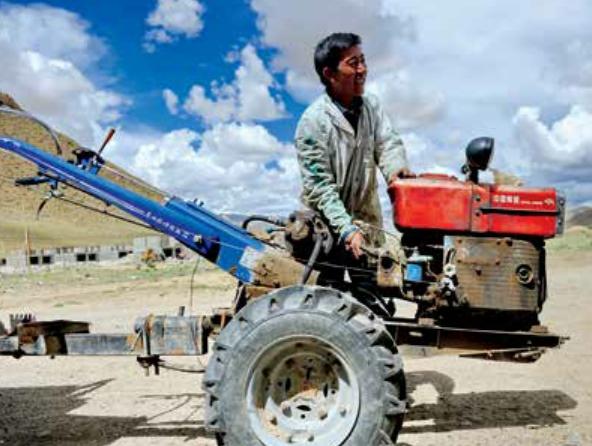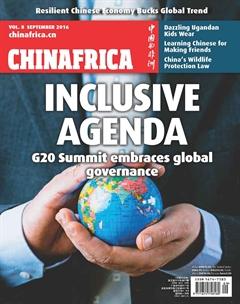Tackling Poverty Head On

China has lifted nearly 700 million people out of poverty in the past three decades and plans to eradicate domestic poverty by 2020. During this period, it has also been assisting African countries and other developing nations to escape from the ravages of poverty. Zuo Changsheng, Director of the International Poverty Reduction Center in China (IPRCC), tells ChinAfrica reporter Yu nan that some of Chinas best poverty alleviation practices are being adopted by African countries with modifications to suit their national conditions.
ChinAfrica: How do you see the differences between targeted approach to alleviating poverty and development-oriented poverty relief policy?
Zuo Changsheng: The concept of targeted approach to alleviating poverty was introduced by the Central Government in late 2013. Its basic requirements and key methods include “six precise items”and “five-channel project.” The former comprises clear targets for individual households, well-arranged projects, precise capital use, targeted measures, sending the right people to help according to different conditions in different places and authentic effects. The latter means poverty alleviation through the following five channels: develop poor peoples own productivity, help them migrate to richer places, provide them with eco-compensation, improve their education, and provide them with social security benefits.
The strategy of targeted approach to alleviating poverty is a significant innovation in the concept, system and policy of China for poverty alleviation and development.
Unlike the countrys previous developmentoriented poverty alleviation policy, the new approach targets specific individual persons or families and ensures it helps those in need, according to their specific difficulties, by corresponding measures. The strategy places greater emphasis on the effectiveness of resources use and actual effectiveness of the poverty relief efforts, so as to ensure that those living in poverty can be lifted out on schedule.
How can Chinas success in poverty reduction be shared with africa?
First, in China, both the central and local authorities have established special poverty relief agencies. The Central Government develops the overall plans and provincial authorities take the full responsibility of implementing them, with county-level authorities helping meet the targets.
China has implemented poverty alleviation programs with varying focuses at different stages. Poverty alleviation has been integrated into the national medium- and long-term economic and social development programs, with increasing inputs from the central and local governments.
Second, Chinas basic approach to poverty relief is to adhere to development-oriented policies, helping people improve their self-development capability.
Third, China has carried out a set of new targeted approaches to alleviating poverty in order to improve the effectiveness of poverty alleviation efforts.
Fourth, the government has mobilized various social resources to the utmost to support poverty alleviation and development efforts.
Fifth, China frequently takes stock of the progress made in this regard to promote innovation in its poverty alleviation programs and their operation mechanism.
In terms of sharing experience with African countries, given the different national conditions, other countries can draw from Chinas practices, but not blindly copy them. In 2011, we initiated the IPRCC Learning Center for Poverty Reduction at Peapea, a village in Tanzania. It was the first village-level poverty alleviation demonstration project in Africa established by the IPRCC. The program aims at sharing experience in poverty reduction in rural China with African countries by offering models in terms of planting, breeding and processing crops. It sets a good example for China-African cooperation in poverty reduction.
What are the challenges China faces in its poverty alleviation effort?
First, the Chinese Government has promised to eradicate poverty by 2020. It means it needs to lift more than 55 million people out of poverty in five years, an arduous task.
Second, most of the people living below the poverty line reside in rural areas with inadequate natural resources and transport conditions. Given the poor ecological environment of those rural areas and the weak economic foundation, reducing poverty in such areas will be costly and more difficult.
Third, the impoverished population has an overall low literacy rate. Also, most of them suffer from diseases and disabilities [which prevent them from working].
Fourth, it is very common to see people returning to their impoverished state due to illnesses and natural disasters. Some migrant farmers have become impoverished after losing their jobs.
There are other problems. For example, due to weak governance and poor management, some poverty relief projects were not effective. Some officials misused the funds or were guilty of dereliction of duty, which impaired the rights of the impoverished. These problems, to some extent, have hampered the implementation of poverty alleviation policies.
Under the State Council Leading Group Office of Poverty Alleviation and Development, a specialized agency engaged in international cooperation for poverty reduction, the IPRCC works as a platform for international exchanges and cooperation in poverty reduction.
Chinese President Xi Jinping has said the IPRCC should contribute Chinese wisdom and strategy to promote experience-sharing in poverty reduction in developing countries.
Since its founding more than a decade ago, the IPRCC has established a series of dialogue mechanisms. These include the Global Poverty Reduction and Development Forum, the Africa-China Poverty Reduction and Development Conference under the Forum on China-Africa Cooperation, and the China-ASEAN Forum on Social Development and Poverty Reduction.
The IPRCC has trained more than 2,000 officials from developing countries. In addition, it has set up bilateral cooperation mechanisms for poverty reduction with many countries and developed village-level poverty reduction demonstration centers.
We also launched the Global Poverty Reduction Inclusive Growth Portal, which aims to become a platform for sharing knowledge about poverty reduction and the best practices in China and around the world.

